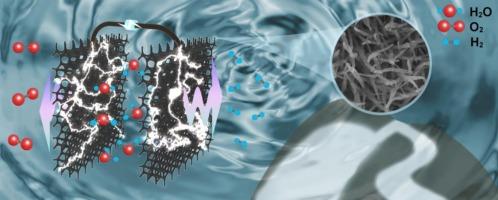双金属锰和铬共掺杂磷化镍钴纳米针阵列作为双功能电催化剂的整体水分解
IF 7.5
1区 工程技术
Q2 ENERGY & FUELS
引用次数: 0
摘要
高效经济的非贵金属双功能水电解催化剂的研究仍然是氢能大规模实际应用的关键。本研究采用经典的两步水热磷化工艺,在导电泡沫镍电极上制备了具有垂直纳米针阵列结构的Mn和Cr共掺杂磷化镍钴双金属催化剂(MnCr-NiCoP)。三维垂直纳米针阵列的横截面直径为~ 40 nm,由大量的~ 10 nm大小的小纳米颗粒组成,可以提供大量的间隙和可用的位置,以促进电解质的运输和电催化反应。结果表明,Mn和Cr共掺杂可以调节局部电子结构,促进电子转移,提高本征活性。尖尖针状纳米线对气泡的吸附能力较弱,有利于气体的解吸。稳定后的MnCr-NiCoP催化剂在10 mA cm−2下的析氧反应和析氢反应的过电位分别为234.8 mV和70.2 mV。作为阴极和阳极的MnCr-NiCoP电解槽在10 mA cm - 2下需要1.42 V的电池电压,同时具有60小时的可承受耐久性。这项工作不仅推荐了一种具有吸引力且具有成本效益的催化材料,而且为基础金属基电催化剂的设计和合成提供了关键策略。本文章由计算机程序翻译,如有差异,请以英文原文为准。

Bimetallic Mn and Cr co-doped nickel cobalt phosphide nanoneedle arrays as bifunctional electro catalysts for overall water splitting
The study of high‐efficiency and economical non‐noble metal bifunctional catalysts for water electrolysis is still critical for large‐scale practical application of hydrogen energy. In this research, bimetallic Mn and Cr co-doped nickel cobalt phosphide (MnCr-NiCoP) electro catalyst with vertical nanoneedle array structure self-supported on conductive nickel foam electrode is fabricated by a classical two-step hydrothermal and phosphating route. 3D vertical nanoneedle arrays present the diameter of ∼40 nm in cross section and are constituted by plentifully diminutive nanoparticles of ∼10 nm size, which can afford a good deal of interspaces and available locations to promote electrolyte transport and electro catalytic reaction. The results prove that Mn and Cr co-doping can regulate the local electronic structure, hearten the electron transfer, as well as improve the intrinsic activity. Furthermore, the acuminate needle-like nanowire is weak in the adsorption of bubble to enhance the desorption of procreant gas. The stabilized MnCr-NiCoP catalyst demonstrates relatively low over potentials of 234.8 and 70.2 mV at 10 mA cm−2 for oxygen evolution reaction (OER) and hydrogen evolution reaction (HER), respectively. The electrolyzer of MnCr-NiCoP as both cathode and anode requires a cell voltage of 1.42 V at 10 mA cm−2 while has tolerable durability for 60 h. This work not only recommends an appealing and cost-effective catalytic material, but also offers a pivotal strategy for the design and synthesis of foundational-metal-based electro catalysts.
求助全文
通过发布文献求助,成功后即可免费获取论文全文。
去求助
来源期刊

Fuel
工程技术-工程:化工
CiteScore
12.80
自引率
20.30%
发文量
3506
审稿时长
64 days
期刊介绍:
The exploration of energy sources remains a critical matter of study. For the past nine decades, fuel has consistently held the forefront in primary research efforts within the field of energy science. This area of investigation encompasses a wide range of subjects, with a particular emphasis on emerging concerns like environmental factors and pollution.
 求助内容:
求助内容: 应助结果提醒方式:
应助结果提醒方式:


